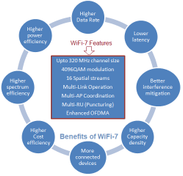Leading WiFi 6E Chipset Manufacturers for Advanced Wi-Fi Solutions
Advertisement
WiFi 6E represents the latest advancement in WiFi 6, expanding the capabilities of the 802.11ax standard to the 6 GHz frequency band. This expansion provides increased bandwidth, reduced interference, and faster speeds, enabling a new level of wireless performance.
WiFi 6E chipsets are designed to take advantage of this additional spectrum, offering ultra-low latency and improved network efficiency for demanding applications like AR/VR, 8K streaming, and industrial IoT. Leading WiFi 6E chipset manufacturers are at the forefront of this innovation, producing advanced solutions that meet the growing need for high-performance wireless connectivity in both consumer and enterprise markets.
What is WiFi 6E?
WiFi 6E extends the operation of WiFi 6 chips based on IEEE 802.11ax into the 6 GHz frequency band. The new chipset offers low latency, high throughput, and higher capacity due to a greater number of channels with 160 MHz bandwidth. WiFi 6E technology adds up to 1200 MHz of extra spectrum to the existing WiFi 6 spectrum. It supports an additional seven non-overlapping channels of 160 MHz in the 6 GHz band.

WiFi 6E supports a different number of channels in various bands for different bandwidths, as shown in the figure:
- 2.4 GHz band: 3 channels (20 MHz), 1 channel (40 MHz), Span: From 2400 to 2483.5 MHz
- 5 GHz band: 25 channels (20 MHz), 12 channels (40 MHz), 6 channels (80 MHz), 2 channels (160 MHz), Span: From 5150 to 5850 MHz
- 6 GHz band: 59 channels (20 MHz), 29 channels (40 MHz), 14 channels (80 MHz), 7 channels (160 MHz), Span: From 5925 to 7125 MHz
Benefits of WiFi 6E over WiFi 6
The benefits of the WiFi 6E standard include:
- Expanded frequency spectrum: Due to the addition of the 6 GHz band with 1200 MHz bandwidth, it adds 7 more channels with 160 MHz wide channels.
- Reduced interference: Due to specific allocation of the 6 GHz band to Wi-Fi 6E devices.
- Lower latency, faster speeds, and higher data throughput.
- Increased network capacity: The extra spectrum significantly boosts network capacity, which allows more devices to be connected simultaneously and provides a smoother and higher-performance experience.
Manufacturers of WiFi 6E Chipsets
The following table lists WiFi 6E chipset manufacturers along with their features and part numbers.
| Manufacturers | WiFi 6E Chipset with features |
|---|---|
| Broadcomm | • Model : BCM4389 • First Wi-Fi 6E client chipset in the World. • Supports tri-band operation and 7 radio chains • In built Bluetooth 5.0 with MIMO 2x2 • Houses 160 MHz channels • Offers about 2 Gbps in phones • Power efficient due to use of 16nm process technology. • Benefits of BCM4389 : 5x higher throughput, 2x less latency, 5x low power consumption, 2x fast bluetooth pairing, zero Glitch Audio and so on. • Also available is WiFi 6 chipset (BCM4375) with integrated Bluetooth 5 |
| Qualcomm | • Models : FastConnect TM 6700 and FastConnect TM 6900 • Supports Wi-Fi 6E and Bluetooth 5.2 • Speed : 6700 delivers about 3 Gbps and 6900 delivers up to 3.6 Gbps • Bands : 2.4 GHz, 5 GHz, 6 GHz • Applications : 1K/4K enhanced gaming, Ultra HD Streaming • Supports superior bluetooth audio using aptX TM • Designed using 14nm process technology • Offers power savings due to less congestion and enhanced scheduling |
| Intel | • Upcoming WiFi 6E chipset is extension to existing WiFi 6 solutions • Availability : 2021 • Supports tri bands • Applications : PCs, Gateways, Home routers |
| ON Semiconductor | • Model : QCS-AX2-A12 • Supports Tri-band viz. 6 GHz, 5 GHz, 2.4 GHz • Supports Adaptive MIMO with 8x8 and 4x4 configurations • Other models : QCS-AX2-T12, QCS-AX2-T8 |
Summary
WiFi 6E chipset manufacturers such as Broadcom, Qualcomm, and Intel are pioneering the next generation of wireless technology. By harnessing the expanded 6 GHz spectrum, these chipsets deliver unparalleled speed, capacity, and performance.
As WiFi 6E adoption accelerates, especially in high-demand environments, these manufacturers are critical to supporting the future of ultra-fast, reliable wireless communication. Their innovations will shape the next wave of connectivity, enhancing user experiences across a broad range of devices and applications.
Advertisement
 RF
RF